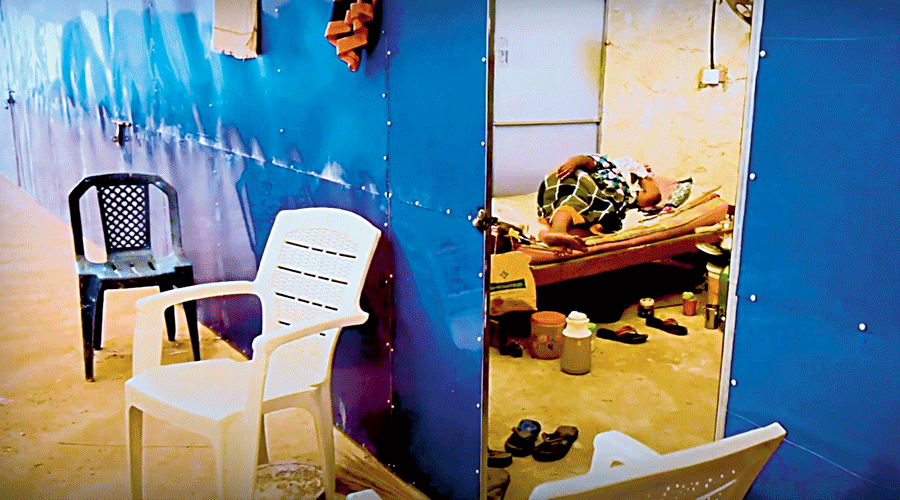Sindhu Maria Napoleon says: “We are fast losing the coast that once belonged to our friends and relatives.”
Sindhu, a researcher on the coastal community, is speaking about the Adanis’ under-construction Vizhinjam port in Thiruvananthapuram, which is accused of causing coastal erosion that has displaced some 300 fishing families and triggered Church-led protests. The Church fears that many more families will eventually be affected.
Sindhu and several others are featured in the documentary film Stolen Shorelines, written and directed by K.A. Shaji, that flags the threats of coastal erosion, high tides and the resultant flooding of fishing villages linked to Vizhinjam port.
The Rs 7,525-crore seaport is coming up as a public-private partnership between the Kerala government and Adani Vizhinjam Port Private Limited. It will be India’s deepest port, capable of handling 80 per cent of the country’s transhipment cargo.
But it has another side, say local people, environmentalists, the Latin Archdiocese of Trivandrum that is leading the protests at the port’s gates, and the Syro-Malankara Catholic Church that has expressed support for the protesters.
Shaji’s documentary focuses on the displacement of hundreds of families from the fishing villages of Kovalam, Veli, Valiytathura, Kallumoodu, Beemapalli, Muttathara and Vizhinjam owing to rising tides and coastal erosion that have swallowed their homes and cut off direct access to the sea.
These fishing families have been moved to relief camps in schools that lack easy access to the sea — or to its shores where they usually dry their nets and repair their boats — which has hit their livelihood.
The state government has offered rehabilitation packages of Rs 10 lakh per family. But the documentary says the sum is insufficient to buy even a small parcel of land anywhere near the seashore.
In the documentary, released early this summer, coastal social worker Nalini Naik says: “Now the government is offering a package of Rs 10 lakh to build a house. How can people build a house (with that amount)? Where will they buy land?”
The state government said on Wednesday — the second consecutive day that work at the project was stalled by protests outside the gate — that it is building 350 flats for the displaced fisherfolk.
The documentary narrates how extensive the damage already is with only 800 metres of the port’s planned 3.1km breakwater completed.
Erosion
Normally, the sea erodes its shores during certain months, especially the turbulent monsoon months, and returns the same volume of sediment to the same shore after a few months.
But breakwaters or any other huge constructions in the sea — and also global warming — can alter the wind and wave patterns and cause the sediments to be deposited in other parts in a process called accretion.
In Thiruvananthapuram, sea erosion is happening north of Vizhinjam and accretion in Pulluvila to the south, whether the extra rocks, soil, clay and sand deposited from other shores have raised the edge of the beach by about 40 metres. This has prevented rainwater from flowing into the sea and turned the area into a vast swamp.
Sindhu and A.J. Vijayan, a former researcher with the International Ocean Institute, said the construction of the port was the main reason for the situation.
Vijayan is featured in the documentary saying that coastal erosion had begun after a minor breakwater was built in the Vizhinjam fishing harbour in 1970. The situation worsened when the construction of the seaport began.
“Country crafts that use outboard engines will not be able to control their crafts because of the surges as a result of the breakwater. Last year four people died in such a surge,” he said, predicting more such accidents when construction picks up pace.
Benny Chirammel, a leader of the Fish Workers’ Collective, said that those the fisherfolk are pitted against are corporations with deep pockets.
“We need to take it very seriously; this is a matter of customary right,” he said.
The project, which got off the ground when the Congress was in power in Kerala as well as at the Centre, has been widely criticised as a “sell-out” to Adani and the Union government. The Left had opposed it when in Opposition but, having won two successive terms, is going ahead with the project on the ground that it is too big to be aborted.
The Adanis’ investment in the project is Rs 2,454 crore while the state government’s share is Rs 3,436 crore and the Union government’s, Rs 1,635 crore. While the Adanis have the right to operate the port for 40 years, extendable by another 20 years, the state government will start receiving its revenue share 15 years after the start of operations.
An Adani Vizhinjam Port spokesperson told this newspaper earlier this year that the company had studied the possible impacts of port construction and obtained approvals from the environment ministry, an expert committee, “which is litigated and upheld by apex court and NGT (National Green Tribunal) of India prior to start of constructions”.
He said the company had followed the “approved rehabilitation and resettlement plan… approved in the EIA (environment impact assessment) and SIA (social impact assessment)”.











